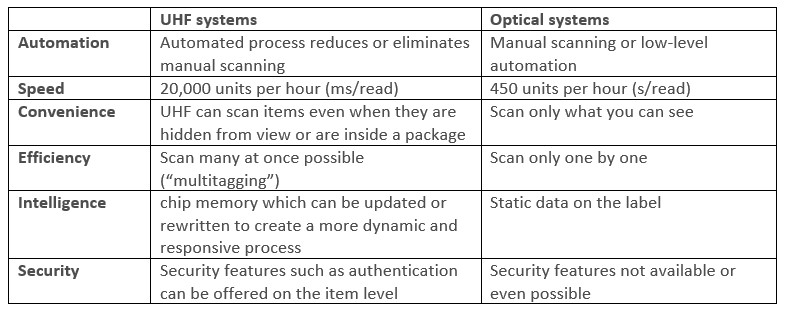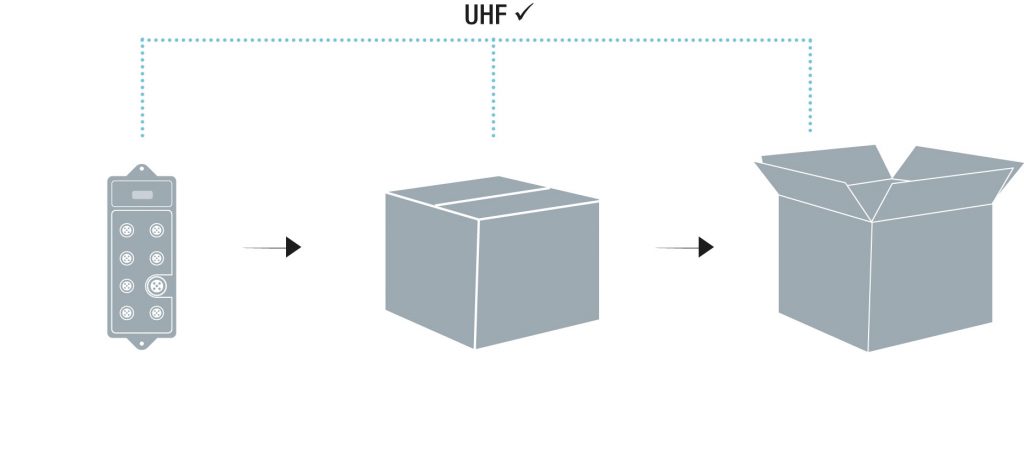Manufactured in batch size 1, bumper to bumper on modular production lines, with the support of collaborative robots – the reality in modern automotive production. Without transparent and continuous processes, production would come to a standstill. Therefore, it is important to have reliable technology in use. For many car manufacturers, UHF is not only used to control manufacturing within a plant but recently more and more also to track new vehicles in the finishing and even shipping processes. And many manufacturers have already started using UHF across production plants and even across companies – with their suppliers. Because it makes just-in-time and just-in-sequence production a lot easier. This blog post gives an insight into why UHF could be THE technology of the future for Automotive production.
But what is UHF?
UHF stands for Ultra High Frequency and is the frequency band of RFID (Radio Frequency Identification) from 300 MHz to 3 GHz. UHF operates with the EPC global Gen2 UHF standard typically in the frequency range of 860 – 960 MHz, with regional differences. Besides UHF other popular RFID frequency bands used in production are LF (low frequency) – operating typically at 125 kHz – and HF (high frequency) – operating typically at 13.56 MHz worldwide. LF is used mainly for Tool ID and HF for ticketing, payment, and production and access control
UHF systems have the longest read range with up to a few meters and a faster data transfer rate than LF or HF. Therefore, it’s used in a wide variety of applications and the fastest growing segment of the RFID market. Tracking goods or car parts in the supply chain, inventorying assets and authenticating car parts are just some examples for the Automotive industry.
And this is how it works: A UHF reader emits a signal and energy to its environment via an antenna. If a UHF data carrier can be activated by this energy a data exchange can take place. The data carrier (often called ‘tag’) backscatters the reader signal and modulates it according to its specific data content.

UHF vs. Optical systems
Intelligent data generated by intelligent RFID solutions is a crucial part of efficient and transparent processes. To achieve this, the use of innovative UHF technology is essential. Because in the long-term UHF could replace existing HF or LF RFID applications as well as optical systems. Due to its wider range of functions and performance, UHF has the potential to enable a cross-enterprise data flow.
This table shows that UHF can offer a performance and interaction that optical formats can’t:

Main advantages of UHF
- Big read ranges of up to a few meters
- “Bulk reading”: Track multiple products (up to a few hundred) simultaneously such as large boxes filled with products passing through a gate or space.
- The data of the UHF data carrier can not only be read, but also changed if necessary
- Cheap labels for one-way use (remaining on the product)
UHF does not necessarily require a direct line of sight to the object to be identified – as long as the data carrier is within the read/write range. It works even with items already packed for sale or transport:

Sometimes short range is required
Although the UHF technology has the ability to read up to a few meters – which is perfect and even required for (intra)logistic processes – this can also be a challenge, especially in some manufacturing areas: Within part production it is often necessary that the detection range is limited and only one part is detected at a time and the neighboring products are not recognized. Here it’s important that the power is either turned down so far that only one part is detected at a time or a special short-range UHF reader resp. special short-range antenna are used.
UHF is the only way forward in the Automotive Supply Chain
The technology’s potential can only be fully exploited if every stage of production is supported by UHF. The use of UHF is versatile and can either be used as closed-loop where the UHF tag stays in the production process or as open-loop with UHF labels that are glued onto or into parts like car bodies, bumpers, head rests, tires etc. and stay there and can also be used during the subsequent logistics applications.
And besides eliminating manual processes you have the full visibility of your inventory (automated!) at any time what helps you to reduce shrinkage and prevent stock losses. This improves your overall business operations. Additionally, you can secure access to certain areas.
Another reason to rely up on UHF is the consistently high standard of data quality. When you acquire the same data type from all areas you can generate trend analysis as the readings can be compared with one another. So, you can obtain extensive information on the entire production process – that would not be possible with mixing different technologies. This gives you the opportunity to put preventive measures instead of just responding to situations all the time.
UHF @ Balluff
To find out more about UHF have a look on our UHF portfolio. If you are specially interested in our UHF short range reader have a look here.






